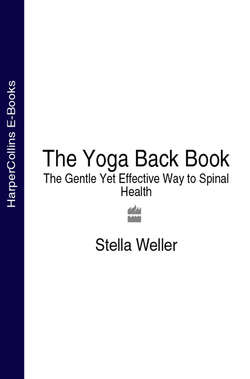Читать книгу The Yoga Back Book: The Gentle Yet Effective Way to Spinal Health - Stella Weller - Страница 5
Introduction
ОглавлениеBack problems have become epidemic. Almost every one of us will experience some form of backache or pain, or related symptom at some stage of our life. Many of us will subject ourselves to unnecessary, ineffective treatments or give up activities we enjoy. Back problems, moreover, have become extremely costly: they result in absenteeism from work and they generate incalculable misery.
And yet according to experts, the care and management of our back is essentially our responsibility, and self-treatment of low back pain and similar problems brings better and more lasting results, in the long-term, than any other form of therapy.
For almost fifty years, I have lived a full and highly productive life, despite a marked lateral curvature of the spine (scoliosis). I attribute this, in large part, to the observation and practice of principles of back care which I now share with you in this book. These are based on the ancient wisdom of yoga – a system of non-strenuous exercises done with full awareness, in synchronization with appropriate breathing, and special mental and breathing exercises that promote relaxation and help in coping with stress.
Yoga, which was tremendously popular in the 1960s and 1970s is now making a strong comeback. I believe this is because of people’s disenchantment with the unfulfilled promises of many high-impact, aerobic-type exercises and the potential of some of them for injury. Yoga is ideal for the millions of people who suffer from backache and related problems. Its gentle movements and the concentration and synchronized breathing it requires make it impossible to hurt yourself, provided the rules are adhered to. One eminent orthopaedic specialist has written, in fact, that as controlled stretching exercise yoga has no peer, and that the mental and physical discipline involved in its practice is superb. Other authors of books on back care have devoted entire chapters to exercises to which they refer as ‘similar to yoga’, an acknowledgement of the respect with which the yoga system is regarded.
This book is intended not only for those of you who are plagued with back problems, but also for those of the privileged minority who aren’t and who wish to keep it that way. It can also be a useful reference for health care professionals such as doctors, nurses, physiotherapists and fitness instructors. It emphasizes personal responsibility in the management of back problems. It also stresses prevention, and provides the tools to help forestall difficulties and maintain the health of the spine and related structures. These tools include information on how the vertebral (spinal) column is constructed, how to use it intelligently and how to care for it through a sensible balance of appropriate exercises, relaxation and sound nutrition.
More than 130 illustrations and photographs complement clear instructions for performing the exercises correctly and safely. These include not only back exercises but also exercises for the legs and abdomen, which are crucial to the health of the back. An entire chapter has been devoted to the principles of good body mechanics, knowledge of which is vital to the prevention of back injury. Yet another chapter focuses on the special needs of those with problems such as chronic fatigue and difficulty with sex, while useful direction is given to pre- and post-natal women.
Hippocrates, known as the father of medicine, emphasized prevention and an awareness of the whole person when treating illness. An important part of this emphasis was the education and encouragement of patients to take responsibility in assisting the therapist with their own care. The Yoga Back Book does just that, and provides information and instruction for helping to put those principles into safe, pleasurable practice in order to bring about the desired results.
